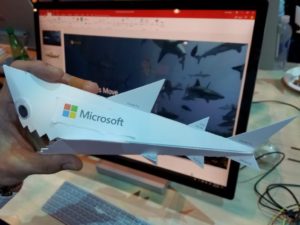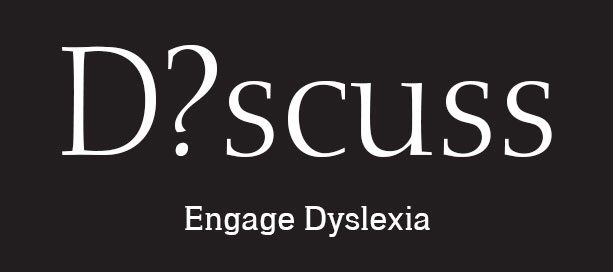Google, Microsoft, Apple, Amazon, and tech’s battle for the hearts and classrooms of teachers
iSpeech
Google, Microsoft, Apple, Amazon, and tech’s battle for the hearts and classrooms of teachers

Microsoft’s edtech presence at ISTE had a STEM and oceans theme. (GeekWire Photo / Frank Catalano)
If the ISTE 2018 exhibit hall was a high school, then Google and Microsoft were the enthusiastically competitive drama and glee clubs, Apple was the cool kid having a smoke off campus, and Amazon had been suspiciously marked absent.
That was the sense of the tech titans’ presence at the largest education technology conference in North America, the International Society for Technology in Education’s annual event held this week in Chicago.
Drawing a record attendance of nearly 19,000 people to the conference and 24,000 to the exhibits, the 2018 ISTE Conference and Expo was a display and discussion of what K-12 teachers and the edtech industry think might be the future of education. For scope and overwhelming scale, it’s the Consumer Electronics Show of digital learning.
While there were hundreds of exhibitors showcasing everything from laptop charging safes to administrative scheduling and grading software, much attention was also paid to the major tech companies that teachers were likely to interact with as much outside of the classroom as within it.
Roughly 24,000 people packed the ISTE edtech exhibit hall in Chicago. (GeekWire Photo / Frank Catalano)
Among the most popular? Microsoft and Google, with huge, packed booths. While both play in digital education content and tools, their ISTE announcements showed a slight difference in emphasis.
Microsoft led with content. A large portion of its presence was tied to STEM curriculum and ocean-themed.
One highlight was the new, free Update Aquatic for Minecraft: Education Edition. With it, students can code to build coral reefs, rescue dolphins, and explore underwater worlds. Less pixelated was the content from a partnership with BBC Learning. Microsoft is promoting new teacher-written, inquiry-based lesson plans about the ocean environment to complement the BBC Earth and OCEANX film, Oceans: Our Blue Planet. (And yes, there is a tie between the coral reefs activities in Minecraft and the BBC film.)
Update Aquatic was a Minecraft: Education Edition hands-on activity. (GeekWire Photo / Frank Catalano)
Microsoft continued to try and set apart its education efforts by emphasizing extended reality. It announced a new Mixed Reality grant program, Limitless Libraries, under which middle and high school and public libraries can apply for a grant that includes two Windows MR headsets and computers, training, and other support. Microsoft said priority for the grants will go to libraries with a STEM commitment and under-served populations.
For its part, Google was more about the classroom tools. It unveiled what it called the “largest updates” yet to its free Google Classroom class management web-based software since it was launched in 2014.
The most significant new feature, Classwork, is a page inside Classroom that lets teachers flexibly organize questions and assignments for students by topic or module (much like a familiar syllabus organizes content). Until now, organization was limited to reverse-chronological order on a Stream page. The Classwork part of Classroom is now in beta with formal release planned for the fall.
Google unveiled a significant update to Classroom, called Classwork. (GeekWire Photo / Frank Catalano)
In addition, teachers will be able to create student quizzes directly from Classroom, and — on managed Chromebooks — lock students out of doing anything else while taking a quiz.
A Google product manager previewing Classwork was careful not to name other products with which Classroom might now compete. But there is a whole category of what are called learning management systems — many paid — to which free Classroom is edging closer.
The word “free” appeared frequently to describe new offerings from Microsoft and Google in K-12 education. It’s probably not a coincidence. Free is seen as a powerful motivator for budget-limited schools and cash-strapped teachers. A week before ISTE, Microsoft even bought the entire edtech startup Flipgrid and made its subscription-based video discussion tool free to all schools.
Teachers have flocked to free. Many edtech startups anticipated that and started out with freemium products. But in some cases, they’ve later restricted free access or folded, frustrating educators and leaving their students out in the cold. Google and Microsoft seem to be leveraging this affinity for free, as well as public confidence in their staying power, to bring teachers into their camps and further raise their profile with educators, students, and parents.
Apple created a Genius Bar replica for teachers at ISTE. (GeekWire Photo / Frank Catalano)
Apple, perhaps too cool for school despite its decades of ed cred, wasn’t in the ISTE exhibit hall at all.
Instead, on a floor down near the convention center entrance, it had set up what looked like an edtech replica of a Genius Bar. Across from it were two closed meeting “classrooms” hosting sessions presenting Apple products and showing how teachers used them with students.
All tickets for Apple’s sessions were gone within one hour of being made available, according to a representative of the company. A schedule board looked like the education technology equivalent of a Chicago airport status display plagued by summer thunderstorms. But instead of ‘CANCELLED’ every timed entry read, ‘SESSION FULL.’
Apple’s off-exhibit-hall sessions filled up immediately. (GeekWire Photo / Frank Catalano)
And Amazon?
The company, which loudly promoted an expanded Amazon Education presence when it launched the Amazon Inspire educational resource site at ISTE two years earlier, was nowhere to be seen. Amazon has been shrinking from the edtech stage, announcing plans to shutter its TenMarks math and writing education business earlier this year.
There was, however, an Amazon presence by proxy, primarily due to Amazon Web Services. Frontline Education, which provides schools with HR and other management software, announced an Alexa skill to let teachers and administrators use voice commands to hear about teacher absences, request a substitute, and do other tasks from home. The policy and advocacy group Alliance for Excellent Education said it was partnering with AWS to create a Future Ready Technology Leaders initiative.
A muted Alexa indirectly represents Amazon via Frontline Education. (GeekWire Photo / Frank Catalano)
There was a lot of other activity on the ISTE floor, too. But many attendees’ attention was on one or more of these four, even as dozens of code-friendly robots from startups crawled the booths and long-established education companies made new curriculum and technology announcements.
When ISTE 2019 arrives in Philadelphia next June, educators may be eager to find out which major tech firms remain at the head of the class, and which are at risk of being suspended.
